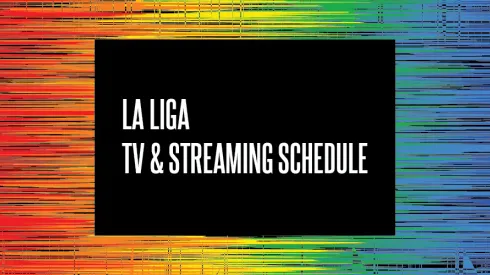La Liga TV schedule
Friday, January 02
- 03:00 PM ET
Rayo Vallecano vs. Getafe (Spanish LaLiga)
Saturday, January 03
- 08:00 AM ET
Celta Vigo vs. Valencia (Spanish LaLiga)
- 10:15 AM ET
Osasuna vs. Athletic Bilbao (Spanish LaLiga)
- 12:30 PM ET
Elche vs. Villarreal (Spanish LaLiga)
- 03:00 PM ET
Sunday, January 04
- 08:00 AM ET
Sevilla FC vs. Levante (Spanish LaLiga)
- 10:15 AM ET
Real Madrid vs. Real Betis (Spanish LaLiga)
- 12:30 PM ET
Mallorca vs. Girona (Spanish LaLiga)
- 12:30 PM ET
- 03:00 PM ET
Real Sociedad vs. Atlético Madrid (Spanish LaLiga)
Browse the La Liga TV schedule below for La Liga games shown on US television and online.
Watch LaLiga on ESPN
ESPN has two of the cornerstones of European club soccer–Bundesliga and La Liga. While ESPN has picked up a plethora of rights from Scotland, Belgium, Netherlands and many other countries, the acquisition of Spain’s LaLiga rights is a major coup for the broadcaster particularly because the league and beIN SPORTS were locked into an exclusive rights deal through 2024.
Watch LaLiga on ESPN+:
Our Pick:Includes: Bundesliga, LaLiga, FA Cup, & More |
 |
As part of a major broadcasting change, ESPN has acquired the U.S. rights to Spain’s LaLiga through 2028-29 in a comprehensive long-term media deal. Select matches will air across ESPN networks each season, but 100% of the matches will be available exclusively via ESPN+.
About the Spanish Soccer League
With so many great teams competing in La Liga including Barcelona, Real Madrid, Atletico Madrid, Valencia, Sevilla, Celta Vigo, Real Betis and others, the league has a lot to offer.
We also have TV listings for LaLiga Santander teams playing in the Champions League and Europa League, summer friendlies, domestic competitions such as Copa del Rey, and games featuring the Spanish national team. Bookmark this page and return to it often. You’ll find the latest schedule of TV games, in many cases posted before the information is officially released.
La Liga History
Presently, there was only one tier, the Primera División, and 10 teams competed in it. Three of the original ten clubs from the Primera División—Barcelona, Real Madrid, and Athletic Club—have remained in the top division ever since 1929.
There would be other situations in the future when the number of clubs expanded. After peaking at 20 clubs in 1987, it has stayed there with the exception of a brief stint (1995–1997), when it was 22 clubs.
The first and second divisions were established simultaneously in 1929. In 1977, the third division was established with the creation of Segunda División B to replace Tercera División. Because of this, the fourth level is now known as Tercera División.
It was Barcelona’s proud moment to become the first La Liga winners. The 1929-30 season was a watershed moment in Barcelona’s history, as their outstanding play laid the groundwork for their eventual win. The team went on to win a slew more championships after this win, solidifying their place in Spanish soccer lore.
Why is it called ‘La Liga’?
There has been a long-standing reputation for the La Liga as the premier soccer competition in Spain. When it was first established in 1928, it was called the “Liga Nacional de Fútbol Profesional” (National Professional Soccer League).
The original name didn’t remain in use much, as it was changed to “La Liga,” which means “The League” in English. A member of the governing committee suggested changing the name because they found ‘Liga Nacional de Fútbol Profesional’ to be too complicated and lengthy.
La Liga is the present title because they wanted something more straightforward and easy to understand.
Rise of La Liga in 20th century
With its spectacular matches and transcendent players, La Liga has become a worldwide sensation, captivating fans on every continent. A long list of famous faces has walked the La Liga stage, including Johan Cruyff, Ferenc Puskas, Alfredo Di Stéfano, and, more recently, Cristiano Ronaldo and Lionel Messi.
From 1936 until 1939, the league was canceled due to the Spanish Civil War. The famous Santiago Bernabeu took over as Real Madrid coach in the 1950s, and the club began its period of supremacy. At the same time, a new soccer style known as “Total Soccer” came into being in the 1970s, with Johan Cruyff and Barcelona serving as its greatest examples.
La Liga: 21st century and modern history
A duopoly emerged in the new millennium that would change the way soccer measured individual greatness. La Liga took a new turn because of the animosity between Real Madrid and Barcelona star Lionel Messi, two of the sport’s all-time greats. They increased the league’s worldwide popularity with their record-breaking feats, record-scoring exploits, and exciting El Clasico clashes.
Even in modern times, La Liga remains a showcase for soccer greatness, giving both up-and-coming players and long-time greats a chance to make their imprint. Beyond its already stellar reputation, the league has become a cultural landmark because of its dedication to innovation and the active engagement of its fans.
Four clubs from La Liga now advance to the UEFA Champions League, with the fifth-place finisher earning a spot in the UEFA Europa League (the Copa del Rey winner also receives a spot). Conversely, the three clubs finishing worst in Primera División (places 18–20) are sent down to Segunda División.
Free resources for US fans
Courtesy of World Soccer Talk, download a complimentary copy of The Ultimate Soccer TV And Streaming Guide, which features details on where to watch all of the leagues from around the world on US TV and streaming, including where to find La Liga games today
To find out when soccer games are on, download the free Soccer TV Schedules App which includes listings of all of the live soccer matches available in the United States (available on Apple iOS devices and Android devices).
If you have any questions about La Liga TV schedule, let us know in the comments section below.














